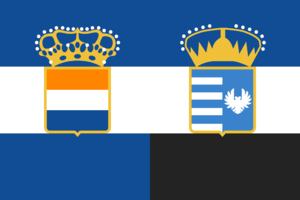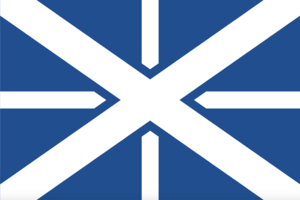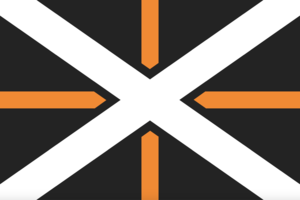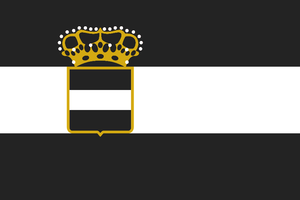Laveska
|
Laveskan Electorate
Лавесканский Электорат
Laveskanskiy Elektorat |
|||||
|---|---|---|---|---|---|
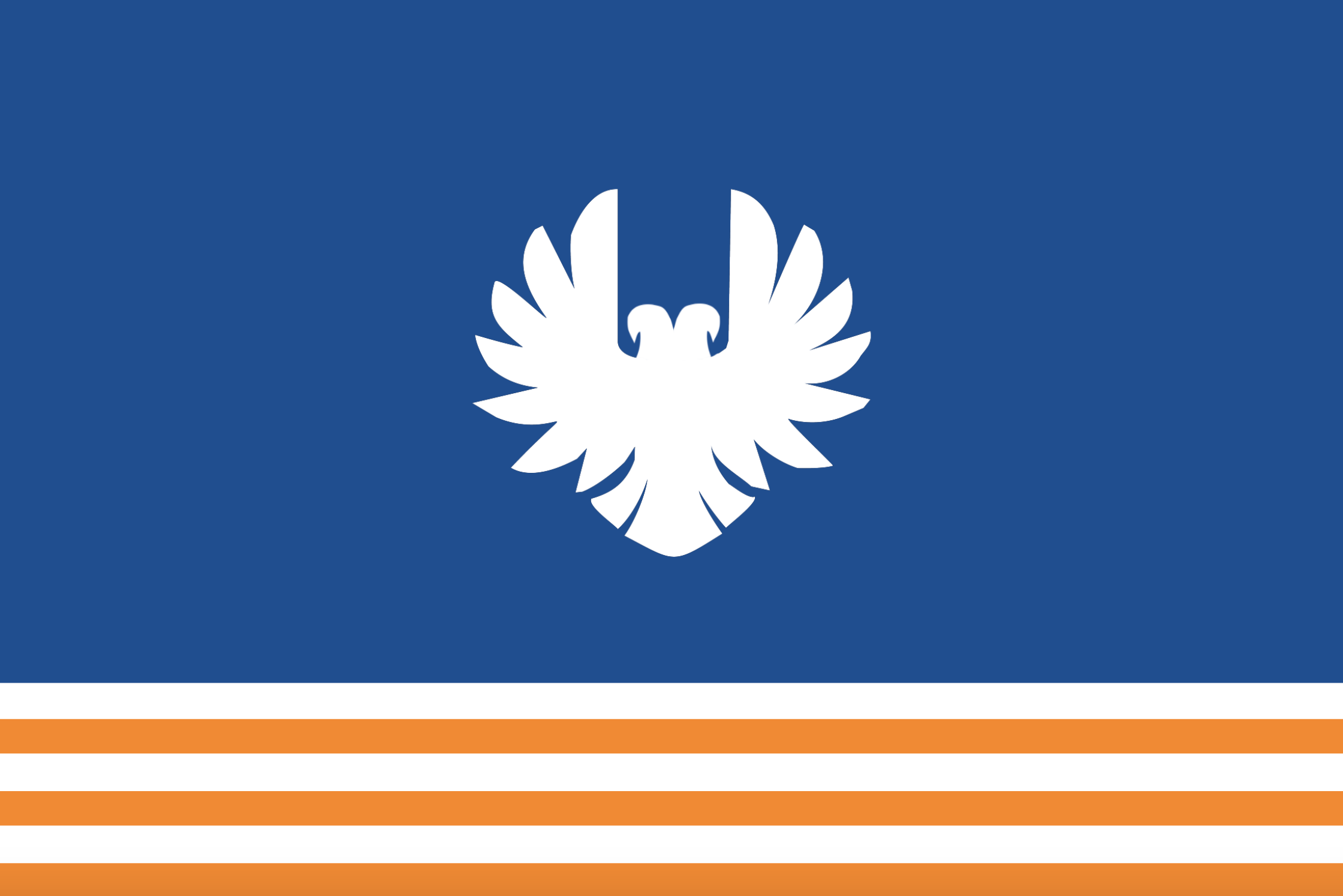 |
|||||
| Sigil of the Asimovtsy (a two-headed phoenix) over a blue field above the orange-white ribbon of the medal "For six decades' service in the Civil War" | |||||
| Motto | Ex Unitate Vires "From Unity, Strength" |
||||
| Common Name | Laveska The Reciprocity Vzaimnostovya |
||||
| Anthem | Дороги Dorogi Roads |
||||
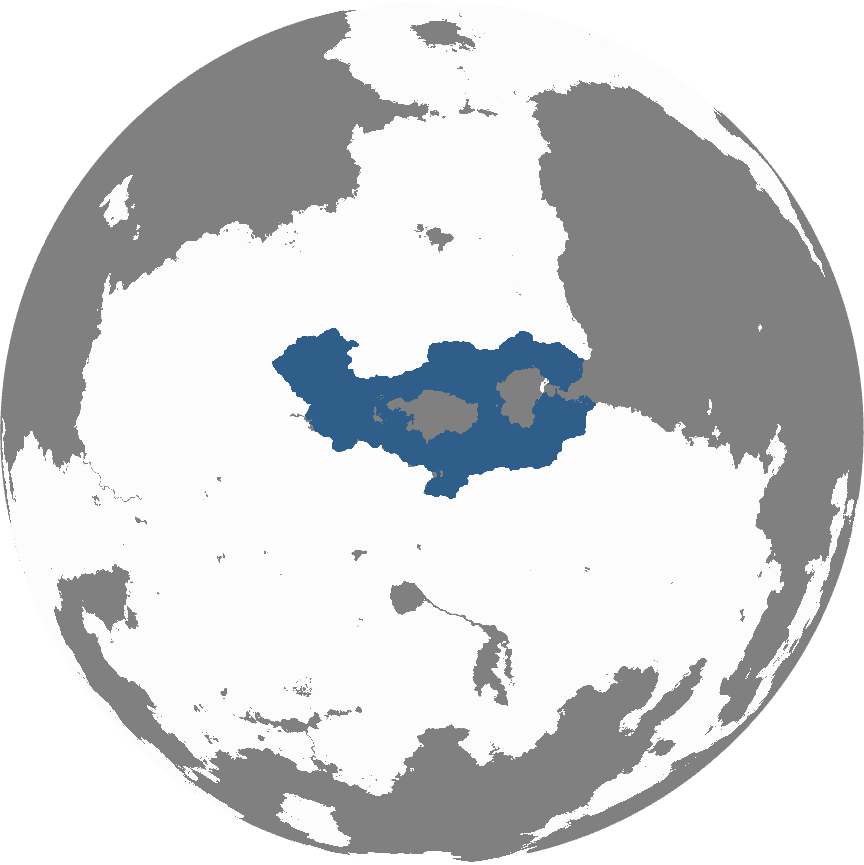 |
|||||
| Demonym | Laveskan | ||||
| Official languages | Aesori (official) Reciprocian Zeroan |
||||
| Currency | Imperial nenarus | ||||
| Politics | |||||
| Capital | Lavesk | ||||
| Government | State within the United Imperial Federation | ||||
| Foundation | 2157 | ||||
| Elector | Isabella Vikus-Ward | ||||
| Preceded by | State Union of Laveska, Zeroa, Nautilus, and Fortmil | ||||
| Demography | |||||
| Ethnicities | Laveskan (42%) Reciprocian (30%) Amberite (12%) Aeserian (8%) Zeroan (5%) Strelkan (0.6%) Zokesian (0.4%) Other (2%) |
||||
| Population | 32,121,370 | ||||
| Area | 46,139 km² | ||||
Laveska, officially the Laveskan Electorate and also rendered as the Reciprocity or Vzaimnostovya, is a federal subject of the United Imperial Federation. It lies on the Wakirian coast and is the easternmost continental Imperial territory. It borders Zeroa to the west, an international border with Belaeseria to the north, and international borders with the Combined Provinces of Doren as well as the Republic of Taiala to the south. As a national subject of the Imperial Federation, the head of state of Laveska is also an Imperial elector in addition to domestic duties.
Prior to Aeserian colonization, the area of Laveska was the central point of a historical region known today as the Reciprocity, a culturally and linguistically diverse area plagued with conflict. The arrival of mercenaries at the end of the first millennium led to the collapse of the old order and the region's reorganization as a unified polity called the Freehold of the Eastern Laveskan Host, before being formally annexed into the Arcadian Tsardom as a governorate and later transformed into a Socialist Republic under the UASR. Following the UASR's collapse, the region came under the control of several successive Reciprocian states before the Shattering of 2081 set off a chain of events that led to the creation of the State Union of Laveska and Zeroa. This state soon merged with the Commonwealth of Nautilus to form the Nautilane-Laveskan Commonwealth, and was a member state of the Imperial United Front that resurrected the United Imperial Federation. Upon the Reconstitution of 2157 the Laveskan government formally ceded all foreign policy sovereignty to the central government of the UIF.
Excluding free cities, Laveska is the most-populated constituent state of the United Imperial Federation, with a total population of 32.1 million. Laveska’s economy is moderately developed, with a focus on industry that has yet to be overtaken by the steadily growing service sector, in part due to the devastation of the previous century. Unlike most Imperial electorates, the Laveskan constitution vests its elector with real power. The Laveskan government has often been labeled as “authoritarian” by some.
Etymology
The name Laveska originates from the Ancient Tauride word Lavesk'ani, meaning "Eternal Fountain." For most of its history, present-day Laveska was known as “the Reciprocity” (Laveskan: Взаимностовя; Vzaimnostovya). Upon the Union of Arcadian Socialist Republics’ annexation of the region. the Reciprocity was renamed to the Laveskan Soviet Socialist Republic, after the Laveskan people, perceived as a “reliable ethnicity” by the central government over the native Reciprocians. Following the reunification of the country in 2134 a national conference was called to determine the name of Laveska and its cities. A compromise was struck whereby the name of the country would remain that of its victorious ethnicities (“Laveska-Zeroa”) but that Reciprocian cities renamed during the rule of the UASR (and not prior) would be reverted back to their original names. Since then Laveska proper has been known as the Laveskan Freehold (2134-2149) and the Laveskan Electorate (2149-present).
History
Antiquity and classical period
The first permanent Kerbal settlements in the territory of present-day Laveska were established 2,000 years ago by Feguanesians sailing west from Huturoa and proto-Crytilian tribes sailing west from the southern Crytilian peninsula. Around the same period, Tauride tribes migrating northeast from the Vocavian land bridge domesticated livestock and began to settle the coast of what is today known as Sweetwater Lake. Encounters between the three groups occurred frequently, and archaeological evidence indicates a high level of cultural and material exchange between all groups in the region. As centuries passed these three protocultures would evolve into the fourteen major ethnicities of the Reciprocity, inheriting dialects of the Tauride languages, a syncretic religious practice, and the maritime tradition of the Feguanesians. Such common cultural foundations, as well as not only the safety of Sweetwater and Bitterwater Lakes as seaborne trade routes but also the richness of coastal and riverine soil ensured the region’s status in antiquity as an abundant and prosperous center of commerce. Fishing towns appeared in great frequency all along the coasts of both lakes. The city-states of Meridonalis, Barcomm, Elista, Hakine, Nonomiya, and Littoral were all founded during this period out of burgeoning fishing settlements. Interethnic and multinational military or trade alliances during this period came to be called “reciprocities.” The need to maintain a motivated corps of rowers for any maritime endeavor facilitated the rapid growth of democracy, albeit with a heavily oligarchic and militarist bent. Influence in Reciprocian political spheres was highly sought after and many states within the region became embroiled in proxy wars on behalf of neighboring money-rich but resource-poor powers. The prevalence of power politics and democratic corruption frequently undermined the early reciprocities, and left the whole area unprepared for the mass Dorvic raids and societal collapse of the early 1000s.
Ravnine Dark Ages
The peoples of the Reciprocity found themselves unable to withstand the Dorvic hordes from the south and east and hopelessly watched as their armies were defeated in the field at Zilo in 1104, again at Ainak in early 1105 and Laveska later that year. By 1112 the entire Reciprocity had fallen under Dorvic control. Most major cities were sacked and several were razed to the ground. While some Dorvic tribes settled in the region and assimilated into local Reciprocian cultures, most did not, and when most of the resources in the region were depleted, the Dorvics, finding the grassland needed to feed their capals increasingly barren and rare, began to migrate north and east starting in the 1300s. The Dorvic withdrawal allowed the peoples of the Reciprocity to rebuild their societies, but it permanently altered the character of Reciprocian diplomacy. The warlord states and tribal confederations that arose from the ashes were highly xenophobic and militaristic. Trade with neighboring nations during this period was almost exclusively to secure military funding.
Raising a professional army from citizen volunteers, an easy task four hundred years prior, became nearly impossible with the erosion of democratic representation and the sheer attrition of constant fighting as the years went on, and levied soldiers were of poor quality. To alleviate these issues, local rulers set to hiring Aeserian, Amberite, and Belaeserian
Grand Mercenary Revolt
For three centuries ethnic Aeserian and Belasrian mercenaries formed companies and would be paid to fight each other at the whim of rich Reciprocan kings with lacking native militaries. Since the various Reciprocan ethnicities and states were extremely xenophobic, the Aeserians and Belarsians were forbidden from marrying local Reciprocan woman, leading many prospective mercenaries who made the trek to marry before departure, bringing their wives to the frontier. Such xenophobic policies had the adverse effect of creating a large ethnic Aesero-Belasrian minority within these lands, of whose main employment was in the soldiery of the warring states. Interethnic tensions rose as these settlers began to find more connections with each other as opposed to their lieges.
Within the Aesero-Belasrian fort towns poets and writers brought to birth a cultural revolution. Among these thinkers was a man named , also a mercenary commander and mayor-captain of the Aesero-Belasrian settlement at Belogore, just east of the major port city of Lavesk and across the strait from Hout, the then crown jewel of eastern Doren. He became ever more involved in this new movement, using his unique position among the poets as a military commander to orchestrate the first victory for a unified Laveskan nation at the 1444 battle of Pegan, wherein through adept use of messengers convinced the opposing army's Aeserian contingent and its commander to join forces with Navarinov's army, both turning on their Reciprocan masters. Following a bloody victory, Navarinov's Aesero-Belasrians and the opposing army's Aesero-Belasrians, led by one Captain Roman Odesovich, joined forces and marched on Pegan. Initially granting the inhabitants of the city mercy, tensions rose as news of a second Reciprocan army returning home to Pegan began to spread. The peasants of Pegan rose up in anticipation of liberation and were swiftly cut down and the city razed. The Aesero-Belasrian population of the nearby fort-towns were invited to repopulate the sacked Pegan, where Navarinov delivered a speech christening these Aesero-Belasrians as "Laveskans." Throughout the following decade, Navarinov, Odesovich, and other Laveskan generals who joined his cause swept across the Reciprocans' lands, exploiting the eternal infighting amongst the Reciprocan lords to divide and then conquer them. By the year 1460 Navarinov's army had reached as far as the Zaror River, and Odesovich's army had secured the entire Reciprocan North after a surprise amphibious landing on Hout. Navarinov proclaimed himself Supreme Ruler (Verkhovniy Pravitel) of all Laveska. Still believing himself to be a subject of the . He thus established a precedent that most future hegemons of Laveska would follow - a humble refusal to add royal title or style to their name.
First Warlord Era
The unified state of Laveska, officially known as the Freehold of the Eastern Laveskan Host, was split into several military districts, each corresponding to a large Laveskan fort-town or area of responsibility of an important general. The captains-general of these districts would be tasked with suppressing native Reciprocan resistance and keeping the population in line. Due to centuries of strife the Reciprocan population remained at a relatively static size, and ethnic Aesero-Belasrians would soon overtake them, already being the majority population in several districts. The military districts would also, in time of Navarinov's death, be tasked with convening at Lavesk and choosing the next ruler.
Cracks in this system began to show when Odesovich was sacked as captain-general of Hout and arrested due to Navarinov taking personal offense to the lavish lifestyle Odesovich had adopted following his conquests, plunging the former prosperous port city into economic decline due to his careless spending. Odesovich was also accused of adultery, domestic abuse, solicitation, exploiting the general populace, and robbing the treasury, and was initially set to be executed, but was spared by Navarinov granting him mercy. Odesovich would spend the rest of his life as a laborer in the reconstruction crew in Pegan.
Fearing the ease at which Odesovich was stripped of his power, the other captains-general in Laveska conspired to overthrow Navarinov and install a tribunal of military governors to administer the country. During this time, Navarinov had begun retiring from political affairs, choosing to spend more of his time at his farm with his wife and two children. Such an action would normally be an innocuous move, but the captains-general were even more offended due to Navarinov's wife being Odesovich's former wife, and moved the coup date further forward.
Some of the captains-general initially on board with the coup backed out when they learned that the ringleaders intended to kill Navarinov's entire family, believing this punishment to be too extreme, especially as Navarinov had granted Odesovich mercy. They moved to inform Navarinov, which forced the revolutionaries' hands. In the early morning hours of 4 October 1481, bribed guards and military units loyal to the usurpers invaded Navarinov's farm, only to discover that he had moved to the palace in anticipation of the revolutionaries' imminent action. Now discovered, the usurpers instead began to wreak havoc in the areas they controlled, plunging Laveska into a civil war.
Navarinov was able to consolidate most of his territory west of the Meridonalis Isthmus but died of old age before he could reunify all of his territory. Considering that the captains-general were at war, Navarinov made the emergency decision to appoint his son Herman Arkadovich Navarinov as Supreme Ruler before dying. The younger Navarinov would prove a competent military leader, ending the strife within the following year, but proved to be a lacking statesman, lacking the skill in statecraft to forge strong bonds with the Laveskan political elite, and would be forced out of power near the end of his life. Though the state would not collapse in such a manner again for another six hundred years, the halls of Laveskan power would be filled with intrigue and assassinations, with the country ebbing and flowing at the whim of the competency of the Supreme Ruler.
Freehold of the Eastern Laveskan Host
Annexation
Union of Arcadian Socialist Republics
A decade prior to the collapse of the UASR in 1984, a progressive cultural revival known as the Reciprocian Awakening swept the Laveskan SSR and ensured its reformation post-collapse into the Lake Periphery States of the Spice Reciprocity. The new government sought to tear down vestiges of its Ravnine past, elevating Reciprocian cultures and delineating interstate borders along ancient ethnic lines. The Reciprocity reformed the internal troops units they inherited into a new military-civil organization devoted to the furtherance of the cultural revolution: the Blue Coats.
The collapse of state institutions, mass catastrophe, and the presence of the Wovians brought to birth a nationwide armed rebellion against both the occupying power and each other. For the next sixty years warlords fought in the Laveskan Civil War, either attempting to secure an independent future for their land or a reunification of the country. The country as a whole remained severely impoverished and at war's conclusion over 80% of the country lived below the poverty line. Early on, Laveskan and Reciprocian warlords fought each other alike, but by 2190 the Ravnine factions had completely allied, whereas the Reciprocian states never would. When the UIF collapsed in 2119, Aeserian exiles crossing the Larkuno corridor joined the war in droves, on the side of the Laveskan warlords. Just as a millennia prior, the alliance between the Aeserians and Laveskans under Generals Asimov, Zhuravlev, and Senyavin and the Zeroans under Generals Petrayev, Aslambek, Arsanov, Maskhadov, and Gelayev emerged unquestionably victorious, forming the State Union of Laveska and Zeroa.
Reciprocity Reborn
The Blue Coats governed the Spice Reciprocity as a confederation of ethnostates, limiting federal power and ensuring state primacy throughout their rule. The Laveskan, Amberite, and Arcadian populations would be marginalized for the next century. Rife with corruption, the Coatists frequently ran afoul of scandal and was wholly unprepared for war when the Red Horde appeared on the Reciprocity's southern border. The ensuing conflict ended in victory for the Reciprocian side, but the destruction caused by the conflict combined with preexisting corruption led to the collapse of the government and the First Reciprocian Civil War. between loyalists and Dust Harvest, a rebel faction.
Dust Harvest prevailed in the conflict and reformed the country into the Dust Harvest States Upon the Lake’s Periphery. Almost immediately following the cessation of hostilities, the leader of the Northern Mercantile Collective, an omnicidal artificial intelligence called the Overlord, began covertly assassinating Dust Harvest's leadership and replacing them with robot impostors subordinate to it. The NMC also similarly compromised the leadership of the legitimist organization "Underground Reciprocity Liberation Organization." The discovery of the Overlord's subterfuge set off a chain of events that culminated in the Second Reciprocian Civil War.
The compromised leadership of the Underground Reciprocity Liberation Organization gained control of the States' ballistic missile systems and turned them on Dust Harvest-controlled cities, causing widespread destruction. A prominent member of Dust Harvest's leadership, Housen, saw the writing on the wall and broke off from Dust Harvest to form his own organization, the Reciprocian Reclamation Army, which through popular support and Zokesian arms supply prevailed over DH and URLO, bringing the conflict to an end and reforming the country yet again into the Lake Periphery States of the Phosphorous Reciprocity. In addition to the ballistic missile strikes, a biological warfare campaign conducted by Dust Harvest rendered vast swathes of Reciprocian farmland infertile.
In response to the dire situation the country faced, Housen enacted a series of policies known as the Economic Reconstruction Plan. The discovery of Phosphorous, a material that could be turned into a light source when diluted in water and agitated, ignited the Clockwork Revolution, a nationwide transition from electrical to clockwork-based infrastructure. Phosphorous mining operations were heavily funded by the central government as part of the Economic Reconstruction Plan. The surplus material mined would be turned into concrete and used to rebuild cities all over the broken country.
Also included in the Economic Reconstruction Plan were the funds and orders to create a massive underwater complex housing the central clockwork computer, which controlled the national Reciprocian grid. Such a system was impervious to cyberattack, but its vulnerability to physical attack convinced the government to weaponize asteroids and place them in orbit of Kerbin. These weaponized asteroids were tasked with destroying the Submachine in the event of an invasion of the country, while also causing enough destruction that no reasonable world power would risk war with the Reciprocity.
Following the Kroman Crusade, Housen secured a spot for the Reciprocity in the recently-formed international organization "New Extranational Organized Council Of Nations," a mutual defense pact. Unfortunately for Housen's calculus, the Combined Provinces of Doren were not a reasonable world power and their invasion of Konig triggered NEOCON's mutual defense clause. Military failures during the ensuing conflict led to the Shattering, the Wovian betrayal, and the downfall of the Reciprocian state in 2081.
The Shattering
Second Warlord Era
The collapse of state institutions, mass catastrophe, and the presence of the Wovians brought to birth a nationwide armed rebellion against both the occupying power and each other. For the next sixty years warlords fought in the Laveskan Civil War, either attempting to secure an independent future for their land or a reunification of the country. The country as a whole remained severely impoverished and at war's conclusion over 80% of the country lived below the poverty line. Early on, Laveskan and Reciprocian warlords fought each other alike, but by 2109 the Ravnine factions had completely allied, whereas the Reciprocian states never would. When the UIF collapsed in 2119, Aeserian exiles crossing the Larkuno corridor joined the war in droves, on the side of the Laveskan warlords.
Reunification
Imperial United Front
Initially, the victorious generals ruled as a junta, reconstruction being the primary priority of the state. In 2142, General Asimov embarked on a diplomatic mission to Nautilus with a formal request to unify the two countries. First Minister Cromwell and his government accepted the request, and thus brought to birth the Nautilane-Laveskan-Zeroan Commonwealth. A colonial expedition the same year exploiting the weakness of Surnish overseas holdings amidst the Burr War brought the island of Fortmil, a former UIF territory, under Commonwealth control, as well as two puppet states in southern Kafrica which soon fell to local Stahl Sieg units.
Asimov declared his adventures in Kafrica a failure, and shifted national resources not already invested in the reconstruction of the Laveskan mainland to his and Cromwell's ultimate project: the restoration of the United Imperial Federation on the Aeserian half of the continent. With the Amberite Civil War drawing to a close, and the Imperial Continuity Army victorious, Asimov and Cromwell sent envoys to the new government to plan the Imperial Reclamation.
In 2148, Nautilus-Laveska, the Systems Commonwealth, Amber, Konig, Union, and Arkeria signed acts of union and as members of the Imperial United Front transferred governmental and military power to Starmarshal Jordock before issuing a joint declaration of war on Ultranationalist Arcadia. Amassing a coalition amounting to most of the countries on the planet, the military campaign to liberate Aeseria was concluded victoriously in less than a year. Aeseria was ruled as a joint reconstruction authority by the Imperial United Front until the official Reconstitution of the United Imperial Federation in 2157.
Reconstitution of 2157
The Reconstitution
As part of the Reconstitution, institutions across the Imperial Federation were reformed and restored, as were internal borders and governance hierarchies. Initially Laveska formed part of the temporary State Union of Laveska, Zeroa, Nautilus, and Fortmil. The Reconstitution partitioned Nautilus and Zeroa from the union and Fortmil was conferred the status of free imperial city. Laveska was given an Imperial Elector and became the Laveskan Electorate, a sub-national state within the United Imperial Federation.
Geography
###
Climate
###
Biodiversity
###
Urban Areas
###
Politics
Government
###
Subdivisions
###
Foreign Relations
###
Demographics
| Nationality | 1984 | 2040 | 2080 | 2134 | 2157 | 2167 | 2177 | 2187 | 2197 |
|---|---|---|---|---|---|---|---|---|---|
| Reciprocian | 55 | 64 | 60 | 40 | 39 | 36.4 | 32.7 | 30.3 | 30 |
| Laveskan | 30 | 28 | 24 | 39 | 40 | 41 | 41.6 | 42 | 42 |
| Amberite | 3 | 2 | 2 | 6 | 7 | 9 | 10 | 11 | 12 |
| Arcadian | 7 | 3 | N/A | N/A | N/A | N/A | N/A | N/A | N/A |
| Aeserian | N/A | N/A | 1 | 5 | 6 | 6 | 7 | 8 | 8 |
| Zeroan | 3 | 3 | 5 | 3 | 4 | 4 | 5 | 5 | 5 |
| Strelkan | 0 | 0 | 1 | 2 | 0.5 | 0.4 | 0.5 | 0.5 | 0.6 |
| Zokesian | 0 | 0 | 3 | 1 | 0.2 | 0.2 | 0.2 | 0.2 | 0.4 |
| Other | 2 | 2 | 2 | 4 | 3.3 | 3 | 3 | 2 | 2 |
Languages
| Language | 2157 | 2167 | 2177 | 2187 | 2197 |
|---|---|---|---|---|---|
| Aesori | 53 | 54 | 55 | 62 | 68 |
| Reciprocian | 40 | 39 | 38 | 31 | 25 |
| Zeroan | 4 | 4 | 5 | 5 | 5 |
| Other | 3 | 3 | 2 | 2 | 2 |
###
Education
###
Religion
| Religion | 2157 | 2167 | 2177 | 2187 | 2197 |
|---|---|---|---|---|---|
| Integralism | 80 | 79 | 76 | 74 | 72 |
| Eubudism | 6 | 6 | 5 | 5 | 5 |
| Other or none | 14 | 15 | 19 | 21 | 23 |
Age
###
Economy
Taxation
###
Transport
###
Energy and Infrastructure
###
Trade
###
Science
###
